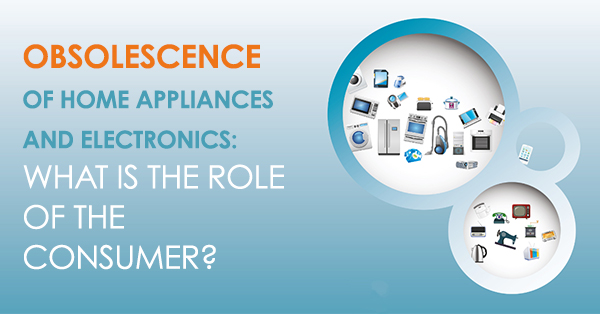Published on
To better understand consumer behaviour and take action to curb the premature replacement of household appliances and electronics
Montreal, May 24, 2018 - Équiterre today unveiled the findings of the first Canada-wide study on obsolescence and the tendency of Canadian consumers to replace their household appliances and electronics (HAEs) prematurely. The study was conducted jointly with several partners specializing in responsible consumption, social accountability and the sharing economy, including RECYC-QUÉBEC, France's Halte à l'obsolescence programmée (HOP), Option consommateurs and the Consumers Council of Canada. The Observatoire de la consommation responsable (OCR) was commissioned to conduct the research on which this study is based.
GIVING THE POWER BACK TO CONSUMERS
The study reveals a growing trend among consumers to replace products, which are often durable goods, before the end of their useful lives. This is not because the products are no longer functional, but simply because the consumer prefers to acquire a new product for technical, aesthetic or psychological reasons. "This study of Canadians' consumption habits highlights solutions for putting an end to the throw-away culture that has seeped into our lives and become the norm," explained Colleen Thorpe, Director of Educational Programs at Équiterre.
A special event to mark the study's release was held today at the Centre for Sustainable Development (CSD). The event featured a panel of experts and a "repairathon" offered by Insertech, where participants could have their electronic devices fixed for free.
OBSOLESCENCE: A NEW AREA OF FOCUS FOR ÉQUITERRE
Alarmed by the phenomenon of overconsumption, Équiterre made a commitment in its 2017-2020 strategic plan to tackle the issue of obsolescence of consumer goods. Excessive consumption has significant impacts on the environment, human health and our economy. This report represents the first step in a reflection that will lay the groundwork for a campaign to fight obsolescence. In addition to providing an up-to-the-minute portrait of Canadians' understanding of the phenomenon of obsolescence and of the causes for the premature replacement of HAEs, it recommends concrete solutions for extending their lifespan for citizens, companies and government.
In 2016, HAEs generated 44.7 million tonnes of waste worldwide, and this volume is forecast to grow by 17% by the year 2021.
THE STUDY AND ITS METHODOLOGY
As part of this study, Équiterre:
● conducted a review of the literature;
● identified over 80 promising initiatives related to the fight against obsolescence;
● carried out a survey of a representative sample of thousands of Canadians on their understanding and behaviour with regards to obsolescence;
● identified several potential solutions.
STUDY HIGHLIGHTS:
● 80% of respondents purchased their appliances or devices new, suggesting a low propensity for reuse;
● 86% of respondents said that HAEs are deliberately designed to have a short lifespan;
● Less than half of consumers are conscious of the role they play in the phenomenon of obsolescence;
● Few respondents keep their appliances beyond what they consider to be their reasonable lifespan;
● Nearly 1 in 5 consumers can be described as being "excessive," having acquired 5 or more devices in the time period studied. The typical profile is that of a man whose average age is younger than the other respondents (46 years), who is an owner and has a relatively high income;
● Only 19% of respondents reported making repairs to their products in the case of home appliances, compared to 26% for electronics;
● Marketing strategies designed by companies, such as promotions, loyalty programs and changes to plan features, can have a significant influence on obsolescence.
OBSOLESCENCE VS PLANNED OBSOLESCENCE
In order to avoid polarizing debates and to emphasize the issue of shared responsibility for the phenomenon, Équiterre has chosen to focus the debate on the simple notion of obsolescence rather than on planned obsolescence.
WASTE REDUCTION
The study reveals that HAEs generated 44.7 million tonnes of waste worldwide in 2016, a volume that is forecast to grow by 17% by the year 2021. "These figures point to the urgent need for effective collective action to minimize the amount of waste we produce. This requires major public awareness and information campaigns. We intend to continue to pursue our efforts in this regard while promoting the benefits of reuse to consumers and of the circular economy to our industries," said Sonia Gagné, president and CEO of RECYC-QUÉBEC.
To read the full report: www.equiterre.org/obsolescence-report
Équiterre received funding from Innovation, Science and Economic Development Canada's Contribution Program for Non-profit Consumer and Voluntary Organizations. The views expressed in this report are not necessarily those of Innovation, Science and Economic Development Canada or of the Government of Canada. Thank you also to RECYC-QUÉBEC.
-30-
For information or to arrange an interview:
Camille Gagné-Raynauld
Media Relations, Équiterre
cgraynauld@equiterre.org
514-701-8134





